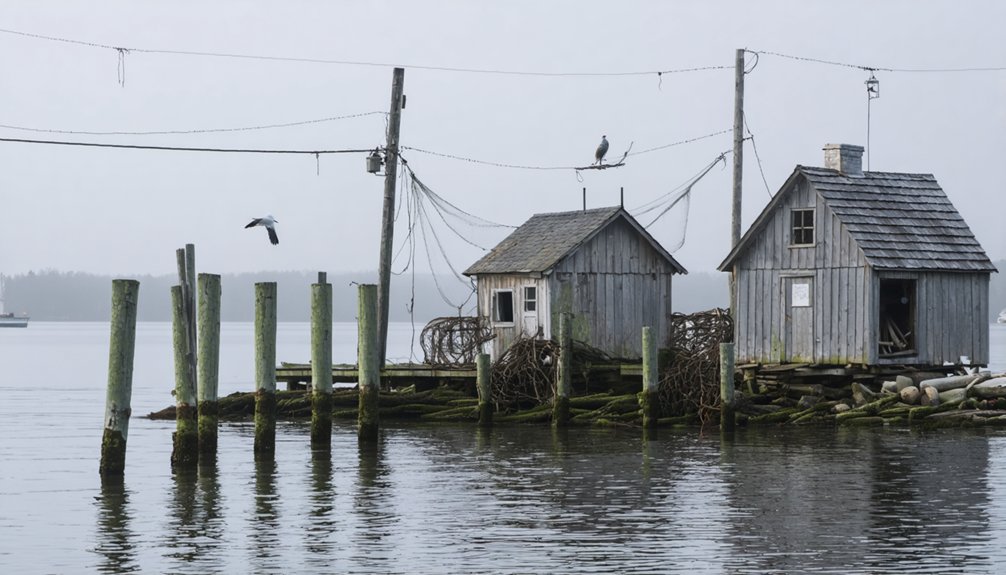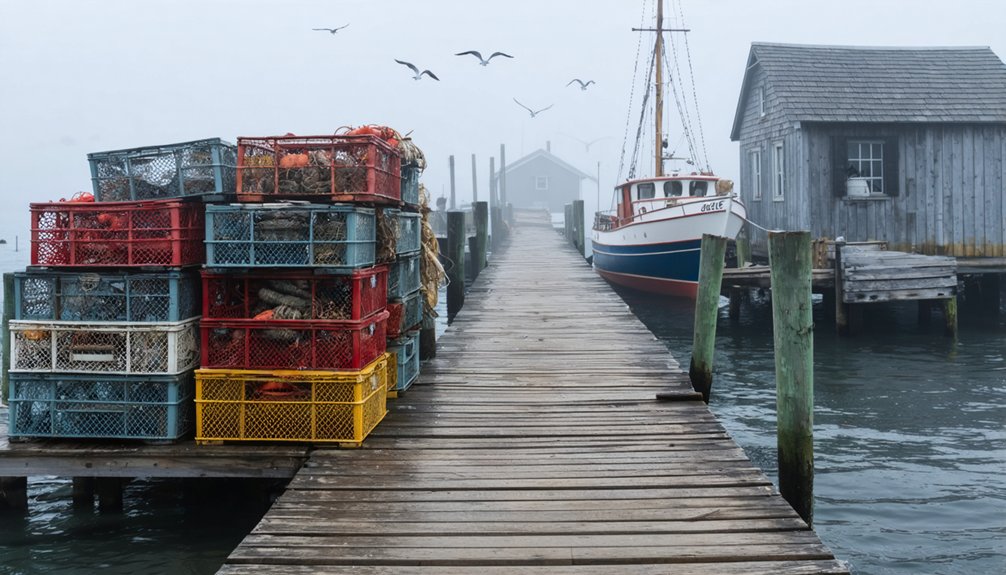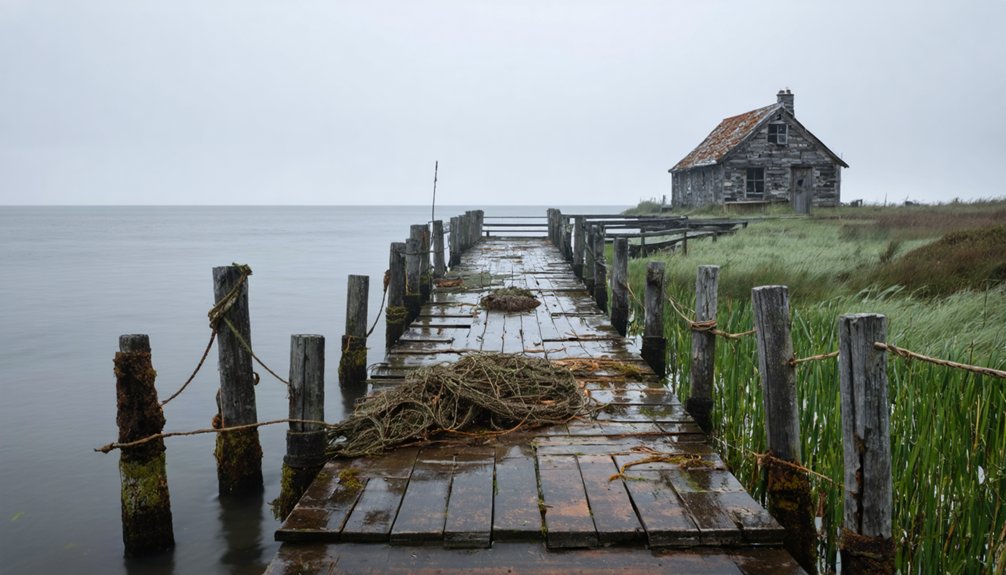America’s coastlines are dotted with abandoned fishing villages that reveal our maritime past. You’ll find Terminal Island’s erased Japanese community in California, China Camp’s preserved Chinese settlement, New England’s forgotten harbors, and hurricane-devastated Gulf Coast outposts. Alaska’s deserted whaling stations, Pacific Northwest’s silent cannery towns, and undocumented Atlantic fishing camps complete the list. These ghost towns offer glimpses into the complex cultural and economic forces that shaped America’s relationship with the sea.
Key Takeaways
- Terminal Island’s Japanese fishing community vanished after Pearl Harbor, erasing decades of cultural heritage and economic contributions.
- China Camp Village declined after discriminatory legislation in 1905-1911 outlawed shrimp exports and traditional fishing techniques.
- New England coastal settlements like Perkins, Maine were abandoned due to natural disasters, economic shifts, and infrastructure decline.
- Isle de Jean Charles, Louisiana is nearly deserted due to coastal erosion and devastating storm surges.
- North Pacific Cannery towns operated until 1980 before economic decline led to abandonment, preserving complex cultural heritage.
Terminal Island: The Lost Japanese Fishing Community of Southern California
Along the southern California coastline, where the bustling ports of Los Angeles and Long Beach now dominate the landscape, once thrived a vibrant Japanese fishing community on Terminal Island that transformed America’s commercial fishing industry.
You’d have witnessed Japanese heritage flourishing as fishermen arrived in the 1890s, initially diving for abalone before pioneering revolutionary fishing techniques for tuna. Their innovative method—using scout boats to catch live bait for spearing tuna with bamboo poles—revolutionized commercial fishing.
By 1941, approximately 3,000 Japanese residents operated 250 fishing boats, creating an economic powerhouse with their own stores, schools, and cultural institutions. The community developed a unique dialect called kii-shu ben that reflected their blended Japanese-American identity.
Tuna Street served as the main hub of social life, featuring a Shinto shrine where community members gathered for cultural and religious events.
This freedom-loving community vanished after Pearl Harbor when residents received just 48 hours to evacuate under Executive Order 9066. Their homes were demolished, businesses closed, and fishing boats restricted—erasing decades of cultural and economic contributions.
China Camp Village: From Bustling Shrimp Industry to Silent Ghost Town
When you visit China Camp today, you’ll find the preserved remnants of what was once a thriving Chinese fishing village that harvested over three million pounds of shrimp annually during its 1880s peak.
The village’s prosperity came to an abrupt end following discriminatory legislation in 1905 and 1911 that outlawed shrimp exports and banned traditional Chinese fishing techniques, causing the once-bustling community of 500 residents to dwindle rapidly.
This fishing community found its home on land that was once part of Timothy Murphy’s rancho, purchased by John A. McNear in 1869 before becoming a haven for Chinese immigrants seeking economic opportunity through shrimping.
Now protected as California State Historical Landmark No. 924, China Camp stands as the last surviving Chinese shrimp fishing village in California, offering you a rare glimpse into an important yet often overlooked chapter of Asian American maritime heritage.
The site was formally established as a state park in 1977 to preserve its historical significance and now includes a museum showcasing the village’s cultural heritage.
Fishing Prosperity Era
During the late 19th century, China Camp Village transformed from a modest fishing settlement into America’s largest shrimp production hub, demonstrating the entrepreneurial resilience of Chinese immigrants who faced significant cultural barriers.
You’d be amazed by the industrial might this coastal community achieved. With nearly 500 residents from Guangdong province, the village’s shrimp fishing operations reached extraordinary levels—harvesting up to 3 million pounds annually in the 1880s. Most of these immigrants had fled to establish these villages due to anti-Chinese sentiment in San Francisco.
Individual boats could collect almost 2 US tons daily using traditional sampans and cone-shaped nets adapted from Chinese techniques. By 1895, Chinese fishermen dominated the industry, harvesting 5.4 million pounds across the Bay Area.
Their operations were so successful that shrimp became the region’s second most valuable seafood product after oysters, with dozens of junks dotting the bay waters. The fishermen exported the majority of their catch to their homeland in China, creating an international trade route despite the growing discriminatory legislation.
Cultural Heritage Preserved
While visitors to China Camp State Park today encounter a serene coastal landscape with weathered wooden buildings and quiet shores, they’re walking through the remains of what was once California’s most prosperous Chinese shrimp fishing settlement.
The village’s cultural significance extends beyond its buildings—it represents the resilience of immigrants who maintained their traditions despite discrimination and legal barriers. The village once had a thriving population that surged to 10,000 after the devastating 1906 San Francisco earthquake. The settlement originally began in the late 1860s when Chinese immigrants sought alternative livelihoods after working on the transcontinental railroad.
Heritage preservation efforts began in 1976 when the area became a state park, protecting this last surviving Chinese shrimp fishing village in California.
- Designated National Register of Historic Places site in 1979
- Recognized as California Historical Landmark #924
- Traditional fishing methods and boat-building practices preserved
- Descendants like Frank Quan maintained authentic fishing operations until recently
You’re experiencing a rare window into 19th-century Chinese American maritime heritage that survived against considerable odds.
The Forgotten Fishing Settlements of New England’s Northern Coast
If you explore the rugged New England coastline today, you’ll find forgotten harbors where stone foundations and cellar holes mark once-thriving fishing communities like Perkins, Maine.
These abandoned settlements, which reached their peak in the early 19th century, relied on robust economic foundations including fish packing operations, lobster sales, and winter ice harvesting before succumbing to environmental and economic pressures. One such community, Whitewash Village on Monomoy Island, Massachusetts, was named for its distinctive whitewashed rocks that guided sailors to shore. Similar to Livermore, New Hampshire, many of these villages were severely damaged by natural disasters that hastened their abandonment.
The physical remnants—from scattered artifacts to preserved structures dating to the 1750s—provide tangible evidence of a lost lobstering legacy that completely vanished by 2000.
Forgotten Harbor Ruins
Along New England’s rugged northern coastline, a scattered collection of abandoned fishing settlements stands as evidence to America’s maritime past, their weathered foundations and crumbling structures largely forgotten by time.
These forgotten relics offer glimpses into once-thriving communities where maritime archaeology reveals stories of resilience and struggle.
- Whitewash Village’s hurricane-ravaged foundations remain visible among coastal rocks, named for the distinctive white-painted stones marking harbor entrances.
- Stone cellars and mill foundations persist beneath encroaching vegetation, creating hazardous but historically rich exploration sites.
- Remnants of fish processing facilities reveal the economic backbone of these vanished communities.
- Personal artifacts scattered across abandoned homesites provide intimate connections to daily life in these harsh coastal environments.
You’ll find these harbor ruins particularly compelling when viewed through the lens of economic hardship and environmental challenges that ultimately defeated them.
Lost Lobstering Legacy
Buried within the fog-shrouded coves and rocky inlets of New England’s northern coastline lies a forgotten chapter of American maritime history—the once-thriving lobstering communities that dominated these shores from the early 1600s onward.
You’ll find these vanished villages predated the Pilgrim settlements, with European fishermen establishing outposts on islands like Monhegan and Damariscove. Their fishing traditions, passed through generations, created tight-knit communities built on shared labor and lobster preservation techniques.
Natural disasters, economic shifts, and infrastructure decline gradually emptied places like Perkins, Maine and Whitewash Village.
Despite physical abandonment, their cultural memory endures through oral histories and folklore. The political ecology of these settlements reveals how isolated communities maintained independence while developing complex resource management systems that modern fishing regulations still echo today.
Hurricane-Ravaged Remnants: Abandoned Villages Along the Gulf Coast
The devastating hurricanes that swept through the Gulf Coast in the early 21st century left behind more than physical destruction—they created a scattered landscape of abandoned fishing communities that stand as silent testimonies to nature’s power.
In your exploration of these ghost villages, you’ll find hurricane recovery efforts fell short in many areas, particularly in smaller towns lacking resources.
Coastal resilience proved challenging when faced with repeated storms and environmental degradation.
- Isle de Jean Charles, Louisiana stands nearly empty, surrendered to erosion and storm surge
- Fishing outposts in Plaquemines Parish remain derelict with collapsed docks and vacant homes
- Once-thriving communities in Mississippi’s Bay St. Louis never regained their pre-Katrina liveliness
- Many settlements faced abandonment after infrastructure collapse and population exodus prevented economic recovery
Whaling Stations of the Aleutian Islands: America’s Northern Frontier Ghost Towns
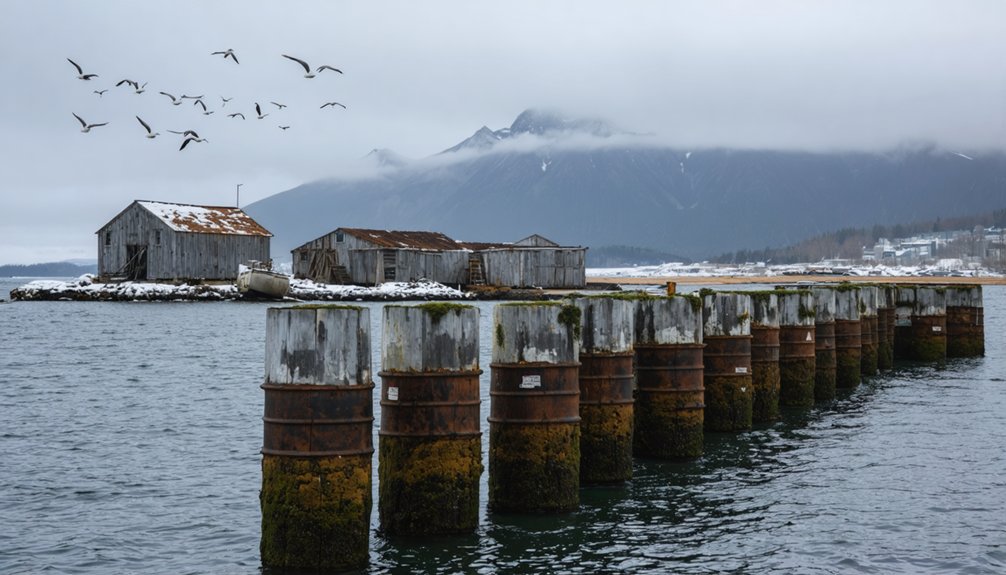
While the Gulf Coast’s abandoned fishing villages tell stories of sudden catastrophe, a different narrative unfolds in America’s far northern reaches.
You’ll find the Akutan Whaling Station—established in 1912 by Norwegian entrepreneurs and the only such operation in the Aleutian Islands—standing as testimony to industrial ambition and eventual ecological consequences.
This ghost town history represents the shift from subsistence to commercial whaling, operating until 1939 when declining whale populations and shifting economic conditions forced its closure.
For nearly three decades, the station processed whales for oil and meat, creating jobs while simultaneously depleting marine ecosystems.
After operations ceased, the abandoned infrastructure slowly returned to nature’s embrace.
Today, these remnants serve as silent monuments to a bygone industry, allowing you to glimpse a controversial chapter in America’s northern frontier exploitation.
The Last Cannery Towns of the Pacific Northwest
Throughout the misty coastlines of Oregon, Washington, and British Columbia, once-thriving cannery towns now stand as weathered monuments to an industry that shaped the Pacific Northwest’s economic and cultural landscape.
You’ll find these ghost villages dotting the shoreline, remnants of an era when salmon canning drove regional prosperity.
- North Pacific Cannery (1889-1980) operated for nearly a century before succumbing to economic decline.
- Cannery workers lived in ethnically segregated quarters, creating distinct communities with Chinese, Japanese, Indigenous, and white neighborhoods.
- By mid-20th century, declining salmon populations and competition from fresh and frozen fish markets decimated the industry.
- Today, these abandoned structures serve as historic sites, preserving the complex cultural heritage of cannery life and labor relations.
Hidden Maritime Heritage: Undocumented Fishing Outposts of the Atlantic Barrier Islands
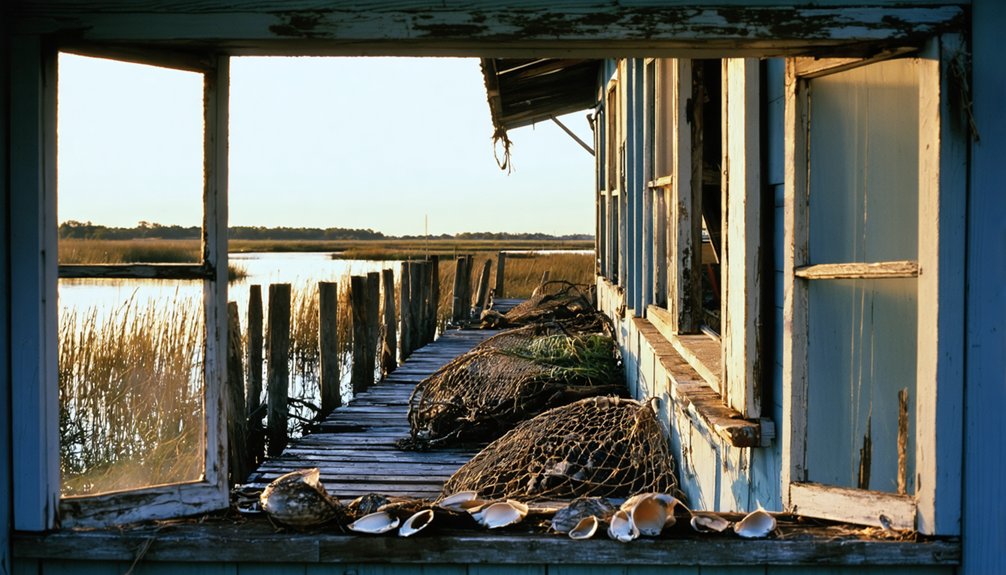
Along the fragile, windswept Atlantic barrier islands, undocumented fishing communities once thrived in isolation, leaving behind a rich maritime heritage that remains largely unexplored by historians.
These hidden heritage sites once dotted Virginia’s barrier islands, housing small fishing villages and hunting lodges that have vanished with time.
You’ll find traces of these fishing outposts in the maritime cultural landscape—place names, remnants of industrial structures, and seasonal camp locations.
Temporary shelters, like the cone-shaped huts built by mullet fishermen on Outer Banks beaches, supported migratory fishing operations.
By the mid-1870s, over 100 bluefish crews worked the waters from Cape Henry to Cape Hatteras, establishing seasonal camps that followed fish migration patterns.
These waterfront-dependent communities represented vital components of America’s economic and cultural identity.
Frequently Asked Questions
What Artifacts Can Visitors Legally Collect From Abandoned Fishing Villages?
You can’t legally collect artifacts without proper permits and landowner permission. Follow legal guidelines regarding jurisdiction and respect ethical considerations that preserve historical context for future research.
Are There Paranormal Reports or Ghost Stories From These Abandoned Villages?
Yes. You’ll encounter numerous ghost sightings in these haunted locations, particularly in places like Yellow Dog Village where apparitions reportedly move through vacant structures following traumatic community evacuations and unexplained illnesses.
How Did Fishing Techniques Differ Between East and West Coast Villages?
You’ll find the east coast employed structure-based fishing with heavy tackle, while west coast villages favored kite fishing and FADs—traditional methods shaped by regional variations in currents and target species.
What Role Did Women Play in These Fishing Communities?
Picture Martha of Gloucester managing market fish sales while her husband’s at sea. You’ll find women fulfilled essential community roles through economic contributions in processing, trading networks, and coastal gleaning operations, while leading environmental advocacy initiatives.
How Did Immigration Policies Specifically Impact Fishing Village Demographics?
Immigration policies altered settlement patterns, triggering significant demographic shifts in your fishing villages. You’ve witnessed how immigration waves reshaped community composition, labor dynamics, and cultural landscapes while influencing maritime migration routes.
References
- https://www.islands.com/1696596/florida-gulf-coast-hides-little-known-serene-cortez-historic-fishing-village-cortez-seafood/
- https://repository.library.noaa.gov/view/noaa/19456/noaa_19456_DS1.pdf
- https://www.messynessychic.com/2021/11/23/the-japanese-fishing-village-that-vanished-from-los-angeles/
- http://web.mit.edu/seagrant/aqua/cmss/marfin/MarfinFinal.pdf
- https://en.wikipedia.org/wiki/List_of_ghost_towns_by_country
- https://www.frdc.com.au/sites/default/files/products/2002-223-DLD.pdf
- https://www.sfgate.com/local/article/china-camp-hike-fishing-village-san-francisco-16236157.php
- https://digitalcommons.uri.edu/cgi/viewcontent.cgi?article=1460&context=oa_diss
- https://www.californiajapantowns.org/terminalisland.html
- https://asamnews.com/2024/05/07/terminal-island-japanese-culture-dialect-fishing-community-california/
